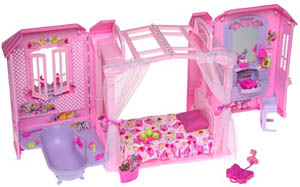Barbie Magic Key House
The magical key really opens things in Barbie doll's house and activates fun surprises.
 The magical key really opens things in Barbie doll's house and activates fun surprises. Girls can: Place the Magi-Key at the front door to see the key light up and hear the doorbell sound play. Place the key in the jewelry box to hear a tune. Use the key to open the window in the bathroom and hear the birds chirping. Barbie can move right in to her own studio apartment with this fold-out dollhouse with three attached sections: a dressing area, a large bed with sparkly white canopy curtains, and a bathroom area with a lavender bathtub and working window shutters. A large pink magic key hangs from a butterfly-shaped key holder, and with the help of three button cell batteries (included) creates three different sound effects in the house: a doorbell, a music box, and birds chirping. The set also includes a flowered bedspread, a pink cloth pillow, a vanity stool, and several pink and green plastic house accessories, such as a lamp and dishes. When playtime is over, the whole house folds together into a compact rectangle with a convenient carrying handle on top.
The magical key really opens things in Barbie doll's house and activates fun surprises. Girls can: Place the Magi-Key at the front door to see the key light up and hear the doorbell sound play. Place the key in the jewelry box to hear a tune. Use the key to open the window in the bathroom and hear the birds chirping. Barbie can move right in to her own studio apartment with this fold-out dollhouse with three attached sections: a dressing area, a large bed with sparkly white canopy curtains, and a bathroom area with a lavender bathtub and working window shutters. A large pink magic key hangs from a butterfly-shaped key holder, and with the help of three button cell batteries (included) creates three different sound effects in the house: a doorbell, a music box, and birds chirping. The set also includes a flowered bedspread, a pink cloth pillow, a vanity stool, and several pink and green plastic house accessories, such as a lamp and dishes. When playtime is over, the whole house folds together into a compact rectangle with a convenient carrying handle on top.
The Evolution of Electronics in Dollhouses
Dollhouses have been a staple of imaginative play for generations. Over the years, with the rise of technology, dollhouses have evolved from simple static structures to interactive, electronic wonderlands. Let's take a journey through the evolution of electronics in dollhouses:
- Beginnings: Traditional dollhouses, particularly those from centuries past, had no electronic components. They were often wooden structures with hand-crafted furnishings and miniatures, serving as a reflection of domestic life of the era.
- Introduction of Lighting: One of the first electronic enhancements in dollhouses was the introduction of lighting. Small wired bulbs illuminated rooms, making dollhouses more lifelike and magical, especially when viewed in dim environments.
- Sound Effects: As technology progressed, some dollhouses incorporated sound effects. This might include doorbells, telephones ringing, or even music playing from miniature radios or TVs, adding an auditory dimension to play.
- Moving Parts: Advanced dollhouses started featuring moving parts powered by motors or batteries. Fans that spin, elevators that move, or garage doors that automatically open are examples of this integration.
- Interactivity: With the boom of digital technology and sensors, newer dollhouses started to incorporate interactive features. Touch a miniature stove, and it might "sizzle"; open the refrigerator, and a light comes on.
- Smart Dollhouses: Mirroring the rise of smart homes, some modern dollhouses have integrated smart tech. Using apps or remote controls, children can adjust lighting colors, play different sounds, or even control room temperatures in these miniature homes.
- Augmented Reality (AR) Integration: Recent innovations have seen the integration of augmented reality in dollhouse play. Using AR glasses or smartphone apps, children can overlay digital elements onto the physical dollhouse, blending the virtual and real worlds.
- Education and Connectivity: The newest generation of electronic dollhouses aims to educate as well as entertain. They might teach children about sustainable living, energy consumption, or home safety. Some are even connected to the internet, allowing for updates and new interactive features.
Through the decades, the integration of electronics into dollhouses has transformed the play experience. What once was a static representation of home life is now a dynamic, interactive, and often educational experience. This evolution reflects the broader changes in society and technology, demonstrating how toys often mirror the advancements and values of their times.
